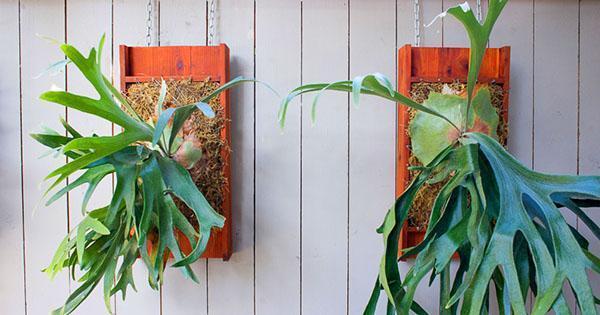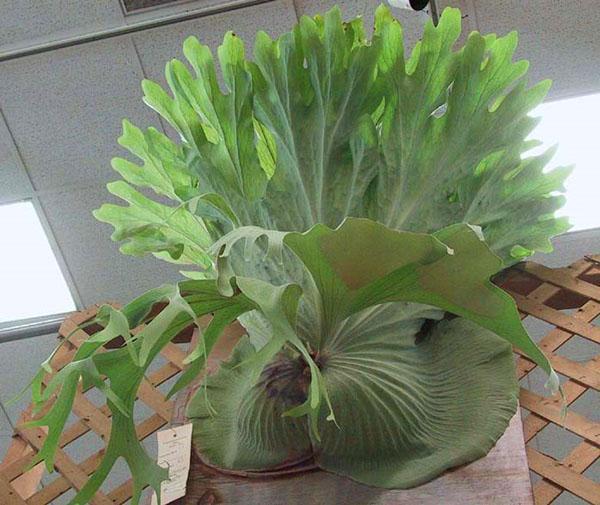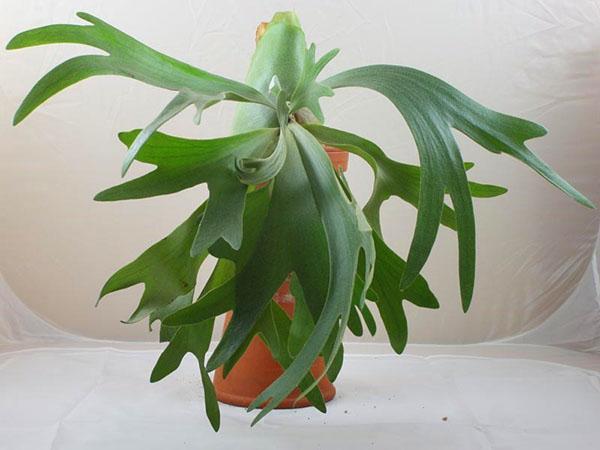Types of platycerium for growing at home
 The genus of unusual ferns Platiterium, which are native to tropical forests, has about 18 different species. But the types of platycerium for the home include only 4 of them.
The genus of unusual ferns Platiterium, which are native to tropical forests, has about 18 different species. But the types of platycerium for the home include only 4 of them.
Platiterium large

Like any other type of Platycerium large, it has two types of leaves:
- wide sterile leaves with deep dissection (their length can reach 60 cm)
- spore-bearing wedge-shaped leaves with a dissection to the middle of the leaf (length can reach 2 meters).
As a rule, due to its large size, this type of Platycerium is cultivated mainly in equipped greenhouses. The plant is demanding for a certain humidity and temperature regime. For comfortable growth and development of the fern, the optimum temperature is +20 - 24 ° C and a sufficiently high air humidity.
The plant does not tolerate direct sunlight, so it feels best in the western or eastern part of the greenhouse.
Do not leave the fern in a draft or near heating appliances.
Platycerium moss
 Platycerium salicherium, or Platycerium two-forked, is the most popular type of this kind of fern for growing at home. Under natural conditions, this type of platycerium grows in the tropical forests of Australia.
Platycerium salicherium, or Platycerium two-forked, is the most popular type of this kind of fern for growing at home. Under natural conditions, this type of platycerium grows in the tropical forests of Australia.
 The fern got its name because of its unusual appearance: the leaves are shaped like moose horns. Spore-bearing wedge-shaped leaves, located on top, can reach a length of 70 cm. Leaf blades of a dark emerald color usually expand at the site of dissection, thus resembling horns. The lower leaves, intended for fixing the plant, are convex, rounded and slightly dissected towards the bottom.
The fern got its name because of its unusual appearance: the leaves are shaped like moose horns. Spore-bearing wedge-shaped leaves, located on top, can reach a length of 70 cm. Leaf blades of a dark emerald color usually expand at the site of dissection, thus resembling horns. The lower leaves, intended for fixing the plant, are convex, rounded and slightly dissected towards the bottom.
Hill Platycerium
 This unusual fern is native to the rainforests of Australia. In appearance, it is similar to the two-forked Platycerium, but differs only in size: Hill's Platycerium is much smaller than the previous species.
This unusual fern is native to the rainforests of Australia. In appearance, it is similar to the two-forked Platycerium, but differs only in size: Hill's Platycerium is much smaller than the previous species.
The leaves of this plant are not as strongly dissected as in other species, and are much straighter. Each segment of the leaf plate is characterized by a pointed end.
Like other species of this unusual fern, Hill's Platycerium prefers diffused light. Otherwise, direct sunlight can cause burns on the leaves and severe damage to the plant.
It is necessary to water abundantly, but it is important to make sure that the soil has time to dry out, otherwise the root system of the Platycerium may begin to rot.
Angolan platycerium
 The homeland of this type of platycerium for the home is the central part of Africa. A distinctive feature of the Angolan platycerium is the fact that the spore-bearing leaves are completely whole and do not have a dissection. The shape of such leaves is wedge-shaped, and their width at the very end can reach 40 cm. The leaves are characterized by a rather pronounced venation and the presence of short, sparsely located red villi.
The homeland of this type of platycerium for the home is the central part of Africa. A distinctive feature of the Angolan platycerium is the fact that the spore-bearing leaves are completely whole and do not have a dissection. The shape of such leaves is wedge-shaped, and their width at the very end can reach 40 cm. The leaves are characterized by a rather pronounced venation and the presence of short, sparsely located red villi.
Plant platycerium stands on a piece of pine bark or tree trunk, or in an ordinary flower pot with a cut on one side.The optimum temperature, as for other species of this fern, is approximately + 19-24 ° C, and the air humidity should be at least 65%.
The choice of the type of Platycerium for growing at home depends only on personal preferences and desires. The main thing to remember is that, like any other plant, this unusual fern requires special care and growing conditions.